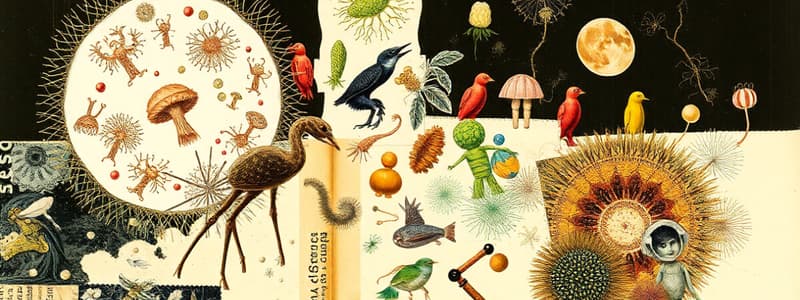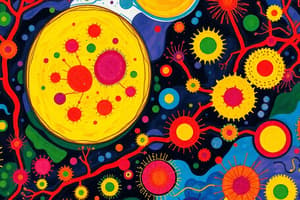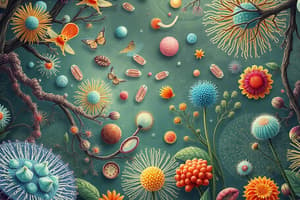Podcast
Questions and Answers
What term describes the adaptation of bacteria to survive in a dormant state?
What term describes the adaptation of bacteria to survive in a dormant state?
- Respiration
- Sporulation (correct)
- Synthesis
- Chemotaxis
Which type of bacteria thrives in highly alkaline environments?
Which type of bacteria thrives in highly alkaline environments?
- Neutrophiles
- Mesophiles
- Acidophiles
- Alkaliphiles (correct)
What is a defining characteristic of Thermophiles?
What is a defining characteristic of Thermophiles?
- They thrive optimally at temperatures below freezing.
- They can survive in the pH range of 5.5 to 8.
- They are best suited for temperatures above 45℃. (correct)
- They prefer temperatures below 15℃.
Which type of signal can Myxococcus use for communication?
Which type of signal can Myxococcus use for communication?
What is the optimal temperature range for Psychrotrophs?
What is the optimal temperature range for Psychrotrophs?
What characteristic is typical of Hyperthermophiles?
What characteristic is typical of Hyperthermophiles?
Which of the following describes structural diversity in microorganisms?
Which of the following describes structural diversity in microorganisms?
What defines an acidophile?
What defines an acidophile?
Flashcards are hidden until you start studying
Study Notes
Microbial Diversity
- Microbial diversity encompasses a broad spectrum of characteristics, including morphology, structure, ecology, behavior, and evolutionary history.
Morphological Diversity
- Microorganisms exhibit a wide range of shapes and sizes, contributing to their morphological diversity.
Structural Diversity
- Structural diversity refers to the variations in the internal and external structures of microorganisms, affecting their functions and survival.
Ecological Diversity
- Microorganisms inhabit diverse environments, from extreme conditions like hot springs to the human gut, demonstrating their ecological diversity.
Behavioral Diversity
- Microorganisms demonstrate diverse behaviors, such as:
- Mode of action: Different mechanisms of action, including nutrient acquisition, waste production, and interactions with other organisms.
- Growth Phase: Different stages of growth and development, influencing their metabolic activities and population dynamics.
- Sporulation: The ability to form spores, enabling survival under harsh conditions.
- Signal Transmission: Communication through chemical and electrical signals, facilitating coordinated behavior and responses to their environment.
- Myxococcus: A genus of bacteria that utilizes signals to trigger membrane fusion and exchange of outer membrane components, contributing to their social behavior.
Evolutionary Diversity
- Microorganisms have evolved over vast periods, leading to a wide range of adaptations and genetic diversity.
Bacterial Diversity: Classification by Temperature Requirements
- Bacteria are categorized based on their optimal growth temperatures:
- Psychrophiles: Thrive in cold environments, with optimal growth temperatures between 0°C and 15°C.
- Psychrotrophs: Tolerate cold temperatures but prefer warmer conditions, optimally growing between 20°C and 30°C.
- Mesophiles: Adapted to moderate temperatures, with optimal growth between 25°C and 40°C.
- Thermophiles: Survive and thrive in hot environments, with optimal temperatures above 45°C. They often possess saturated fatty acids in their membranes to maintain membrane integrity at high temperatures.
- Hyperthermophiles: Found in extremely hot environments, with optimal growth temperatures exceeding 80°C. They are typically archaea, such as the genus Thermodesulfobacterium.
pH Requirements for Bacterial Growth
- Based on their pH optima, bacteria are categorized as:
- Acidophiles: Prefer acidic environments with pH ranging from 0 to 5.5.
- Neutrophiles: Adapt to neutral pH conditions, with optimal growth occurring between 5.5 and 8.
- Alkaliphiles: Thrive in alkaline environments with pH values between 8 and 11.5.
Studying That Suits You
Use AI to generate personalized quizzes and flashcards to suit your learning preferences.




